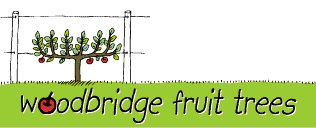No products
 View larger
View larger
What are dwarfing fruit trees? How to make a prolific orchard?
by Bob Magnus | © 2006 Woodbridge Fruit Trees | www.woodbridgefruittrees.com.au
The Greek historian Theophrastus writing in about 350 BC recorded that Alexander the great sent home to Greece from Asia minor plant material of the 'Spring apple', a dwarf, self rooting form of malus. This message from almost 2500 years ago is the first reference to what became known as the paradise apple. From the many subsequent references that survive, it appears that the Romans too were conversant with grafting and found dwarfed apples fitted very happily into formal Roman garden culture. By these means they were widely disseminated throughout the Roman Empire. There is conjecture that the name 'paradise' is connected somehow to the garden of Eden. In any case, what was started by the Romans was continued by the monastery system in Europe during the middle ages, and by the time of the Renaissance, paradise rootstocks were firmly established throughout Europe, especially in the gardens of the aristocracy and the church.
By 1900 when fruit growing was becoming more specialised and scientific, it was realised that there was a great confusion in the rootstock materials found in the nursery trade. Research began at East Malling research station in Kent to standardise the available material and find those most suitable for orchard production. That is why virtually all our clonal rootstocks have a prefix EM (East Malling) often shortened just to M or later MM (Malling Merton). The EM rootstocks were mostly collected throughout Europe and the MM rootstocks were the result of controlled crosses between many species of malus both wild and cultivated.
Starting at EM 1 the research continued until 1952 with EM 3461! This amount of research, dedication and attention to detail is mind boggling to a mere apple grower like me. Well - one may ask, why all this fuss and work to produce dwarf apple trees? Why not just produce nice big ones as nature intended?
It’s all to do with control and quality. Small growing trees are very precocious starting to bear fruit usually in their second year (if you grow them well that is). They are easier to spray and prune and harvesting is more efficient. Many varieties of apples have a biennial habit - that is they tend to bear a huge crop of fruit one year and have a rest the next. Varieties on dwarfing rootstocks are much easier to thin in the 'on' year thereby not stressing the tree too much and so to bear more regularly.
Work done at our research station here at Grove in Tasmania also showed (very important this!) that fruit quality on dwarfed stocks was much higher than on seedling stocks and that the fruit stored and transported better. This was due to available calcium supply both within the tree and the fruits themselves.
Also in our Australian environment dwarfed trees can easily be protected from birds and wildlife predation (see my espalier article) . For the home gardener it’s perfect to grow 4 or 5 dwarf trees, providing fruit over 4 or 5 months in the space of one large tree. Some varieties such as Gravenstein, Mutsu, Jonagold and Blenheim Orange (these are triploids and give no viable pollen) are notoriously slow to start bearing on normal rootstocks - up to 9 years - whereas on dwarfing rootstocks they are precocious and begin to flower in their third year.
In Australia the move to dwarfing rootstocks was very painful for the apple industry, and even today some orchardists continue to grow trees on seedling rootstocks. This is because of several reasons: - seedlings are much cheaper to produce - dwarfing stocks cannot cope with replant situations like seedlings can - dwarfing trees are planted at much higher density, so instead of 150 - 200 trees per hectare, an orchardist may have to buy 1000 trees - a big cost difference.
Anchorage is not as good in dwarf trees and cropping is heavier, so wires and systems have been developed to support the trees.
The home garden fruit tree business in Australia has focused on big vigorous looking trees with big glossy labels in garden centres with staff seldom conversant with fruit tree culture. The trees have to sell themselves - and we all know that bigger is better. In reality the opposite is true.
This is what YOU should do:
- Firstly don’t buy big trees in garden centres.
- Keep pruning to an absolute minimum (difficult for a nation that just loves pruning...)
- Tie down upright growing branches rather than cut them (upright branches grow leaves, sideway branches grow fruit)
- Let the tree crop early. DON’T do as the books say and remove all the fruit for the first years. Leave some fruit. It pulls the branches down and inspires you to give your little tree even more attention.
- Don’t start to irrigate trees in spring until you feel it’s really necessary.
- Early irrigation makes more vegetative growth than fruit.
- Don’t over fertilize trees. High nitrogen levels are a recipe for growth vigour and low fruit quality. Over fertilisation also seems to cause calcium deficiency. Calcium is deficient in most Australian soils and apples have trouble taking up calcium from the soil. Many orchardists use calcium sprays. Glassy core and bitter pit are caused by a lack of calcium.
In short: for a productive home orchard: buy dwarf trees, plant them close, don’t let weeds compete, keep pruning to an absolute minimum, keep branches horizontal and don’t fertilize heavily.
by Bob Magnus | © 2006 Woodbridge Fruit Trees | www.woodbridgefruittrees.com.au
The Greek historian Theophrastus writing in about 350 BC recorded that Alexander the great sent home to Greece from Asia minor plant material of the 'Spring apple', a dwarf, self rooting form of malus. This message from almost 2500 years ago is the first reference to what became known as the paradise apple. From the many subsequent references that survive, it appears that the Romans too were conversant with grafting and found dwarfed apples fitted very happily into formal Roman garden culture. By these means they were widely disseminated throughout the Roman Empire. There is conjecture that the name 'paradise' is connected somehow to the garden of Eden. In any case, what was started by the Romans was continued by the monastery system in Europe during the middle ages, and by the time of the Renaissance, paradise rootstocks were firmly established throughout Europe, especially in the gardens of the aristocracy and the church.
By 1900 when fruit growing was becoming more specialised and scientific, it was realised that there was a great confusion in the rootstock materials found in the nursery trade. Research began at East Malling research station in Kent to standardise the available material and find those most suitable for orchard production. That is why virtually all our clonal rootstocks have a prefix EM (East Malling) often shortened just to M or later MM (Malling Merton). The EM rootstocks were mostly collected throughout Europe and the MM rootstocks were the result of controlled crosses between many species of malus both wild and cultivated.
Starting at EM 1 the research continued until 1952 with EM 3461! This amount of research, dedication and attention to detail is mind boggling to a mere apple grower like me. Well - one may ask, why all this fuss and work to produce dwarf apple trees? Why not just produce nice big ones as nature intended?
It’s all to do with control and quality. Small growing trees are very precocious starting to bear fruit usually in their second year (if you grow them well that is). They are easier to spray and prune and harvesting is more efficient. Many varieties of apples have a biennial habit - that is they tend to bear a huge crop of fruit one year and have a rest the next. Varieties on dwarfing rootstocks are much easier to thin in the 'on' year thereby not stressing the tree too much and so to bear more regularly.
Work done at our research station here at Grove in Tasmania also showed (very important this!) that fruit quality on dwarfed stocks was much higher than on seedling stocks and that the fruit stored and transported better. This was due to available calcium supply both within the tree and the fruits themselves.
Also in our Australian environment dwarfed trees can easily be protected from birds and wildlife predation (see my espalier article) . For the home gardener it’s perfect to grow 4 or 5 dwarf trees, providing fruit over 4 or 5 months in the space of one large tree. Some varieties such as Gravenstein, Mutsu, Jonagold and Blenheim Orange (these are triploids and give no viable pollen) are notoriously slow to start bearing on normal rootstocks - up to 9 years - whereas on dwarfing rootstocks they are precocious and begin to flower in their third year.
In Australia the move to dwarfing rootstocks was very painful for the apple industry, and even today some orchardists continue to grow trees on seedling rootstocks. This is because of several reasons: - seedlings are much cheaper to produce - dwarfing stocks cannot cope with replant situations like seedlings can - dwarfing trees are planted at much higher density, so instead of 150 - 200 trees per hectare, an orchardist may have to buy 1000 trees - a big cost difference.
Anchorage is not as good in dwarf trees and cropping is heavier, so wires and systems have been developed to support the trees.
The home garden fruit tree business in Australia has focused on big vigorous looking trees with big glossy labels in garden centres with staff seldom conversant with fruit tree culture. The trees have to sell themselves - and we all know that bigger is better. In reality the opposite is true.
This is what YOU should do:
- Firstly don’t buy big trees in garden centres.
- Keep pruning to an absolute minimum (difficult for a nation that just loves pruning...)
- Tie down upright growing branches rather than cut them (upright branches grow leaves, sideway branches grow fruit)
- Let the tree crop early. DON’T do as the books say and remove all the fruit for the first years. Leave some fruit. It pulls the branches down and inspires you to give your little tree even more attention.
- Don’t start to irrigate trees in spring until you feel it’s really necessary.
- Early irrigation makes more vegetative growth than fruit.
- Don’t over fertilize trees. High nitrogen levels are a recipe for growth vigour and low fruit quality. Over fertilisation also seems to cause calcium deficiency. Calcium is deficient in most Australian soils and apples have trouble taking up calcium from the soil. Many orchardists use calcium sprays. Glassy core and bitter pit are caused by a lack of calcium.
In short: for a productive home orchard: buy dwarf trees, plant them close, don’t let weeds compete, keep pruning to an absolute minimum, keep branches horizontal and don’t fertilize heavily.
Reviews
No customer reviews for the moment.

